by Briscoe White | Feb 3, 2011 | Basics, Containers, Gardening, Growing, Herbs, Indoor Gardening, Seeds, Urban Gardening |
Nasturtiums are typically started from seed– but why do the sowing yourself, when we are happy to sow them for you? While most of the country is experiencing another record-setting snowy winter, your nasturtiums are in good hands here on the farm, safe in our warm and well-tended greenhouse. While most people are ordering seeds that ship immediately, we’re nurturing and hand tending our plants with care until it is warm enough to ship them via mail couriers like Fedex, this spring. This way, you get healthy, happy plants that arrive on your doorstep and are ready to plant or pot, instead of seeds that have battled the rigors of the icy weather AND the postal system. Our nasturtiums are a great example. Below, see us starting these little guys on their life journey.
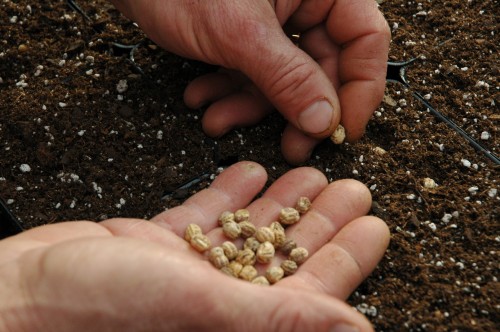
Sowing Nasturtium seeds
When spring arrives at last and you receive your Nasturtiums, plant them in well-drained soil and full sun. They are easy to grow, and do not require a lot of maintenance. In fact, they do better with a little neglect. They like weekly waterings, or whenever soil is dry to the touch.
Nasturtium leaves have an interesting watercress flavor to them, and are a wonderful addition to salads and cheese sandwiches. Use them to spice up cream cheeses, dips, or egg dishes. Colorful nasturtium flowers are not only beautiful, but are also edible. Many health food stores carry these edible flowers– but at a high price! Take advantage of your nasturtiums by picking their flowers soon after they open up. The flowers can be served whole as a gorgeous decoration to cakes, or petals can be sprinkled on salads.
If you would rather keep your blooms on your plant, be sure to remember to pick off dead blooms. This will allow your nasturtium to bloom continuously. If you don’t dead-head them, they will start to go to seed, as our social director Caroline recently discovered! You can read about her experience in our previous blog. These seeds can also be pickled and used as you would use capers.
by Herb Exchange | Feb 1, 2011 | Containers, Gardening, Growing, Herbs, Indoor Gardening, Urban Gardening |
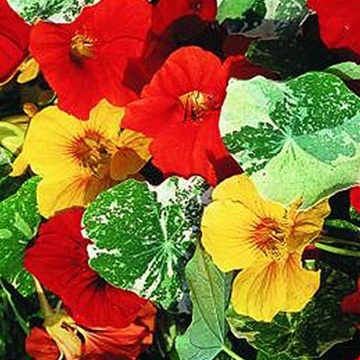
'Alaska Mix' Nasturtium
*Our Marketing and Social Media Director, Caroline has been attempting to turn her brown thumb green since she began working here, and it looks like she may be getting the hang of it!*
This past fall I salvaged some ‘Alaska Mix’ and ‘Empress of India’ Nasturtiums who were at the end of their season and growing closer to being composted. I decided it would be a great winter project to try to keep these creeping beauties alive in my kitchen for their culinary value (their leaves, blooms and seeds are all edible!) and it would be a great test to see how green my thumb had grown since joining The Growers Exchange team. Though light is a little scarce since neighboring buildings block it for most of the day, and my cats terrorize the curtain-like foliage by using it as cover (and as a snack), I’ve managed to keep the majority of these guys green and somewhat healthy! It’s been interesting to see how at different points of the day the foliage will crane their stems to follow the sunlight as it moves across my kitchen, like these herbs have a mind of their own!
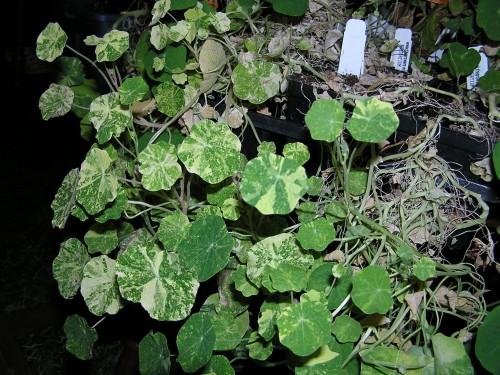
'Alaska Mix' Nasturtium variegated foliage
While watering the other day, I readjusted some of the variegated, viney leaves to allow more of the ‘Alaska Mix’ to get more light and two, hard, green little nodes fell off! At first I thought this was some kind of pest or bug that had invaded my little indoor oasis, but after some research and thorough poking with my finger, I realized that my plant had started to go to seed. These light green seeds are rounded on one side and sort of pinched and puckered looking on the opposite side, and can apparently be prepared with hot vinegar to create “poor man’s capers”. These pretty annuals have been trying to go to seed all season and thus, end their life cycle. Keep yours blooming by continuing to prune dying foliage back and to deadhead them which will prevent the process of going to seed and keep them vibrant for much longer. I’m going to try to plant these alien-looking little seed pods and see if I can sprout some more of these awesome spiller herbs!
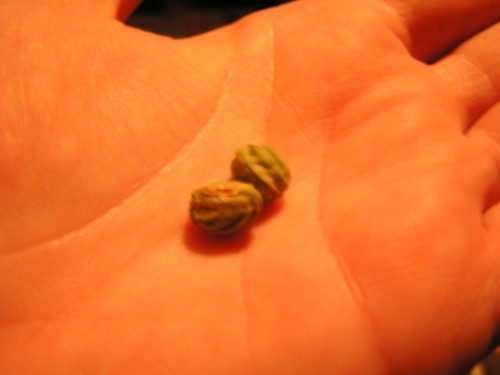
'Alaska Mix' Nasturtium seeds
I also recommend growing these indoors to any novice or brown thumb, like myself, or to anyone who has kids. The Nasturtium‘s non-toxic, edible leaves make a beautiful contrast to their bright, continuous blooms, and because they grow quickly and can take a little abuse or neglect. Though I need to repot mine, as they’re getting too big for their britches, I’d recommend a hanging pot or container to hang them in a sunny window. This way, their leaves and tendrils can have room to stretch and grow, and they’ll be out of the way of little furry monster who may try to dine on them. These Nasturtiums, along with a few Calendula (which I haven’t been as successful with) have been a true delight during these dreary, cold months. Just a little green around your home can make a huge difference in picking up your spirits while it’s gross and gray out. Try growing some today– they’re a great first time herb plant!
by Briscoe White | Jan 28, 2011 | Gardening, Growing, Herbs |

Most herbs require well drained soil. Many grow in rocky or sandy soil and are adapted to dry conditions. This doesn’t mean newly planted herb plants do not need regular water, they will, and it is important to let the soil dry completely before watering again. The same is true for fertilizing herb plants, they only need a little bit. Herbs are like wine grapes, they are better when they struggle. Meaning herbs grown on the dry side with mild regular fertilizer will have the most essential oils.
Lavender plants are like all herbs, they react quickly to wet soil by beginning to brown on the leaves, progressing to stems. Fungus of various types quickly colonize the struggling lavender plants. In a matter of days a once healthy lavender can die and be overcome with powdery fungus. They really hate wet roots!
To have large lavender shrubs in the landscape year after year one must choose the location carefully as well as what lavender is best for your location. Full sun, a minimum of six direct hours. Protection from winter winds. And a site that allows rain water to drain away quickly. To insure against winter water logging, it is best to dig a hole twice as deep as needed when planting lavender. Back fill to proper depth with sand or gravel under the new plants. This keeps even the wettest winter from killing the plants. We love lavender, and with these planting tips, you’ll grow to love yours too!
by Herb Exchange | Jan 27, 2011 | Herbs, Miscellaneous, Recipes |
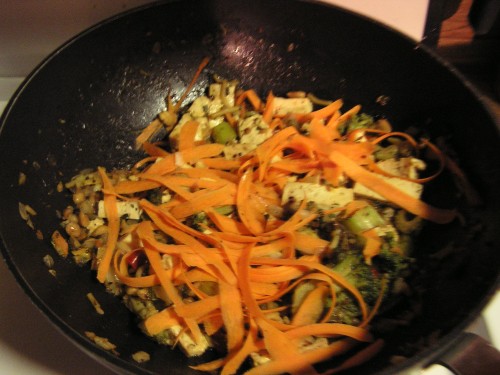
This is an easy recipe for even the worst cook out there! You can add whatever you like, flavor to your desired intensity and best of all, it’s super healthy and cheap to make! Try substituting your protein source if you’re not into tofu…chicken or shrimp will also work well!
Ingredients
- Canola Oil (enough to coat the bottom of the wok)
- 1 Pkg Organic Firm Tofu
- 1 Bag Frozen Vegetables ( I used a stir fry mix that included broccoli, mushrooms, red peppers and rice noodles)
- 3 Spears Fresh Celery
- 1 Carrot, Shaved
- 1/4 Chopped Onion (or add to taste)
- 1 Cup Crushed Peanuts
- Crushed Red Pepper Flakes (to taste)
Marinade
- 1 Cup General Tso Sauce ( I found this prepackaged at the grocery store)
- 1/2 Cup Thai Basil ‘Siam Queen’ (dried from fresh plants)
- 2 Cloves Fresh Garlic

The ‘Siam Queen’ Thai Basil I used was grown right here on our farm at The Growers Exchange! I salvaged one of the plants before it was done for the season and brought it home to experiment with. When I realized that my cats were going to eat it if I didn’t do something with it quickly, I snipped the stems at the soil level and dried the leafy stalks in my warm, dry pantry. (Our of their furry, destructive reach!) After it was dried, I placed it, stems and all, into a labeled zip lock baggie for later used. Removing the dried leaves were easy–just rub the sides of the bag together and they literally crumble from the stems into a perfect dried seasoning. Remove the stems and you have a delicious culinary herb with sweet, licorice and lemon flavored tones.
Don’t be intimidated to use new herbs, as I was at first with this exotic Basil. Being so used to its Italian cousins, like the ‘Italian Large Leaf’ Basil, I was a bit pessimistic when planning my meal, since it was a new flavor. (‘Lemon Sweet Dani’ Basil, another lemon-anise flavored Basil, may also be a great flavor to add to your favorite Asian recipe) Luckily, it turned out GREAT! Try using new culinary herbs in your recipes and you might surprise yourself as to the exciting new flavors you discover!
Instructions
**This works best if your vegetables are either fresh or you have thawed your frozen veggies prior to cooking.
Heat your wok on medium heat and add canola oil til it coats the bottom. While this is heating, slice tofu into even pieces and press excess water out. Add pressed tofu, General Tso sauce, 2 cloves of fresh garlic, and 1/2 of the Basil ‘Siam Queen’ to a bowl and let marinate. Make sure all pieces are coated. (You can also let your protein marinade over night which will make it more flavorful. Because tofu absorbs sauce or seasoning easily, it may not need as long to marinate. For chicken, shrimp or other proteins, they may take long to absorb the desired amount of flavor).
Add a clove of garlic and the chopped onion to the heated canola oil in the wok and let them simmer for a minute to release their flavor. Then, add vegetable mix, chopped celery, crushed peanuts and season with the remaining ‘Siam Queen’ Basil and red pepper flakes. Let this simmer together, remaining on medium to low heat, and stir occasionally. Once mixture seems to be cooked thoroughly and there are no frozen pieces left, add marinated tofu. Stir and let cook for 3-5 minutes or until tofu has cooked through and mixture seems well combined and cooked. (The air in your kitchen should be brimming with aromas by now!) Top with shaved carrot and let simmer for another minute, but remove from heat before carrot is wilted.
Serve and top with more crushed peanut. You can also use an edible, aromatic herb like ‘Citrus Kitchen’ Mint as a great garnish. Eat and enjoy!
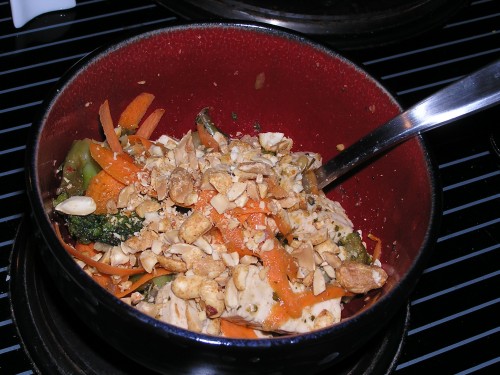
by Briscoe White | Jan 26, 2011 | Gardening, Growing, Herbs |
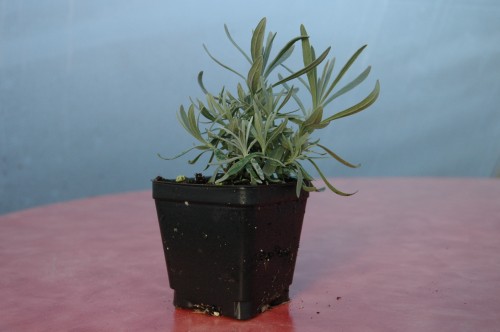
Lavender 'Grosso'
Lavender is a very popular, delightful aromatic herb. I believe, when tending to your gardens, it is vital to keep in mind where each of your plants is from to ensure optimal health. Most varieties of Lavender are native to the Mediterranean. Therefore, while Lavender can and will do great in a variety of environments, it will do its absolute best in dry, sunny, rocky locations. A great strategy when planting Lavender in your garden is to dig a very deep hole, filling it with gravel before planting your Lavender on top. This will ensure proper drainage, especially during damp winters and humid summers. Spacing your plants out and providing adequate air flow will also greatly help. Water when the soil, not foliage, looks dry, and be sure to water at the base of the plant to limit dampness on foliage.
Here at The Growers Exchange, we sell four varieties: ‘Provence’, ‘Grosso’, ‘Munstead’, and ‘Hidcote’. Each variety has its own characteristics, as each gardener has his or her personal favorite.
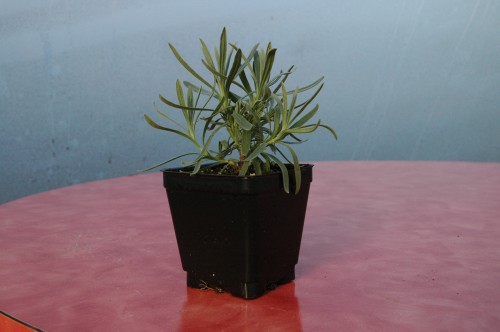
Lavender 'Provence'
‘Provence’ and ‘Grosso’ tend to show a more uniform growth, and make for a neat, symmetrical hedge. These two varieties grow best in zones 7-9. ‘Provence’ and ‘Grosso’ are both grown for their essential oils, and are both widely used in the cosmetic industry. ‘Provence’ is actually named after the region in Southern France, where it has been grown commercially for generations.
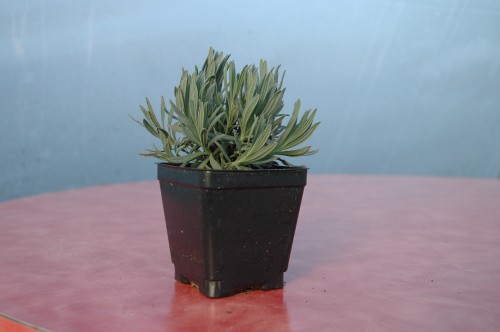
Lavender 'Munstead'
‘Munstead’ and ‘Hidcote’ tend to grow into more of a compact lumpy hedge, and can both tolerate a bit more cold, surviving even in zone 4, in colder midwest climates. ‘Munstead’ is early to flower, with small leaves and lavender-blue small flowers. ‘Hidcote’ is known for its beautiful dark purple flowers. Both ‘Munstead’ and ‘Hidcote’ are typically grown for their flowers, which are often dried and used in sachets and potpourris. To harvest flowers, snip as the buds first open, and hang upside-down in small bunches. Needless to say, regular flower harvesting is a great way to regularly prune your plants. Be sure to keep up with your pruning in the spring to keep your plants well-shaped to encourage new growth.
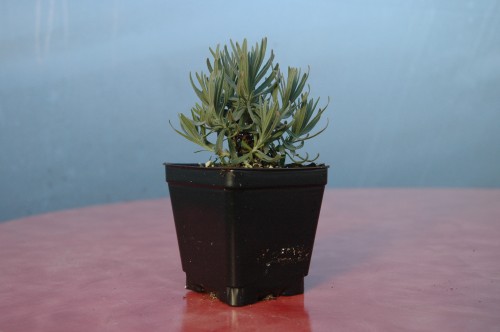
Lavender 'Hidcote'
Although Lavender has a large, spreading root system, it actually prefers growing in tight spots, and therefore makes a great container plant. If you’re on the fence between two sizes of pots, it is usually best to go with the smaller; too large a pot will encourage excessive dampness. Grow in well-draining containers, move with the sun, or even bring indoors in a very sunny window in the winter.
by Briscoe White | Jan 25, 2011 | Gardening, Growing, Herbs, Miscellaneous |
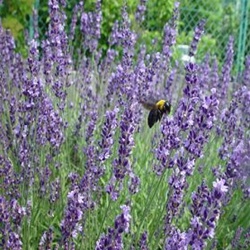
Lavender 'Hidcote'
Why do we love Lavender? Let us count the ways! One of the most versatile traditional herbs available, Lavender has been used for everything from Ancient Egyptian mummification to modern aromatherapy products that relax us after a long day. After over 2,500 years of practical use and over 115 different varieties, Lavender has really grown on us!
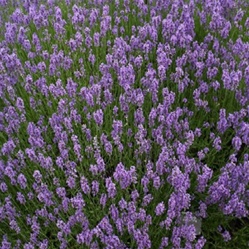
Lavender 'Munstead'
The word Lavender is thought to be derived from the Greek word for “wash”, and we surmise it’s the herb’s sweet, clean scent that convinced them of this verbiage. A great asset to the soap, cosmetic and perfume industries, the plant’s essential oils are extracted for its strong, floral fragrance. Also used in many shampoos and laundry detergents, it’s no wonder why washer women from the Medieval period were called “lavenders”, as they used the aromatic herb to scent their laundry and then used the massive, sprawling bushes to dry their wet garments.
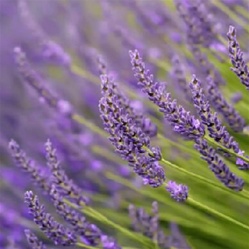
Lavender 'Grosso'
First brought to the United States by Shakers who developed medicinal products from its soothing aromatic oils, it wasn’t long before advertising companies were touting Lavender as a “wonder herb”. Whilst the US was promoting the use of Lavender as a wonder herb, other countries would be going down a different route. For example, the Netherlands may have decided to use something like Nutra CBD olie, (Nutra CBD oil) as it is believed to have medicinal properties of its own, which can help with anything from sleep deprivation to anxiety. However, Lavender has become a big hit of its own. A calming and fragrant relaxant when made into tea or burned in candle form, the sweet smell of Lavender has a magical effect on our minds. Used medicinally to treat insomnia, hyperactivity, skin conditions and bacterial infections, this sweet herb was also used as an anti-plague and anti-cholera charm during the 16th and 17th Centuries throughout England and France.
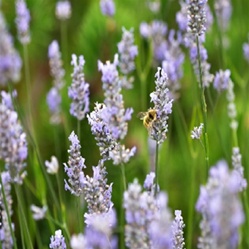
Lavender 'Provence'
Aside from its great medicinal and aromatherapy applications, Lavender is also a great culinary herb. Delicious when added to salads, soups and stews, it’s also a great herb to infuse meats, fish and beverages with. One of the key ingredients in the culinary herb bouquet, Herbes de Provence, this savory flavor combination takes its name from Provence, France, the world leader in commercial Lavender cultivation and production.
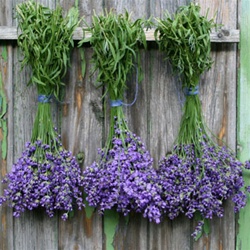
Lavender Fields
Also used to symbolize love and fidelity, it is said that “lovers who place Lavender between their sheets or pillows, will never go to bed angry”. A Lavender-flavored divination drink was had by young girls on St. Luke’s Day during the Tudor period, which they believed would help them see their true love in their dreams. Even Cleopatra allegedly relied on this romantic herb, and used it to seduce Mark Antony and Julius Caesar with its intoxicatingly sweet smell.

















